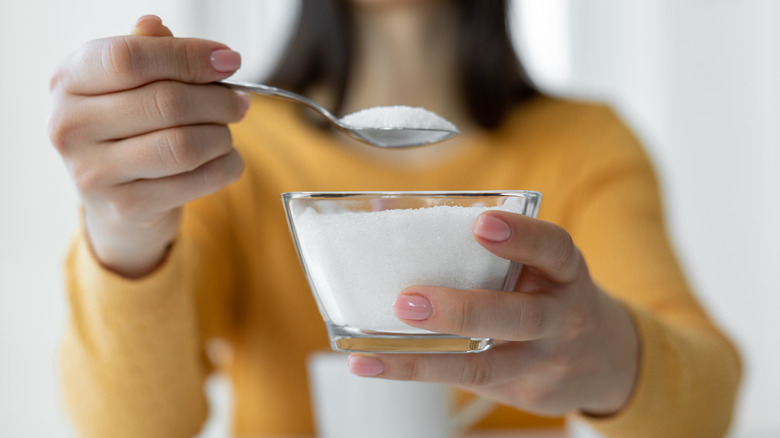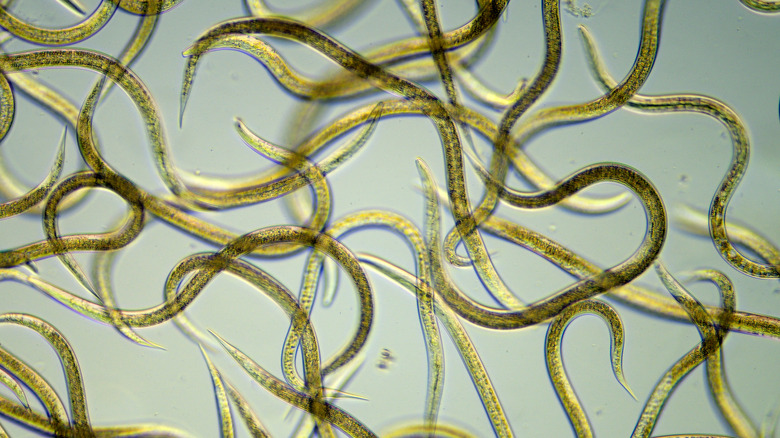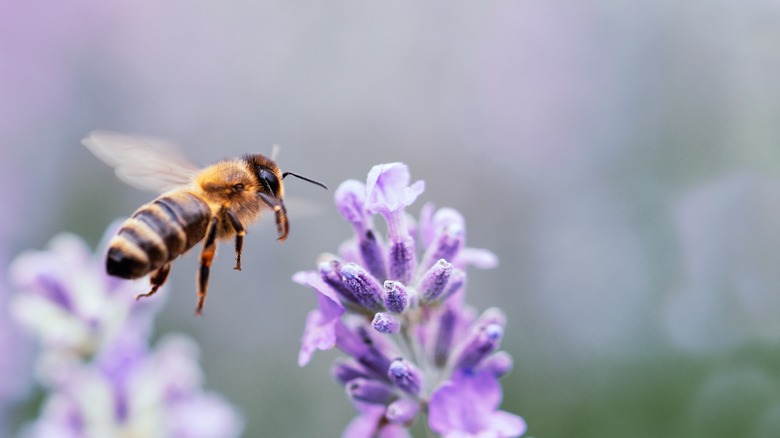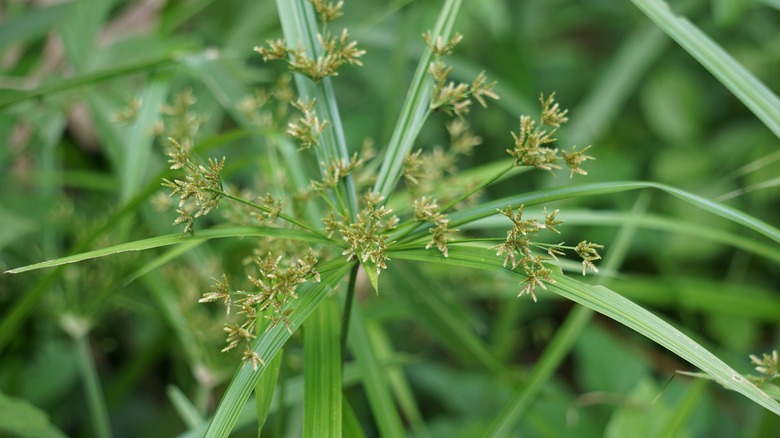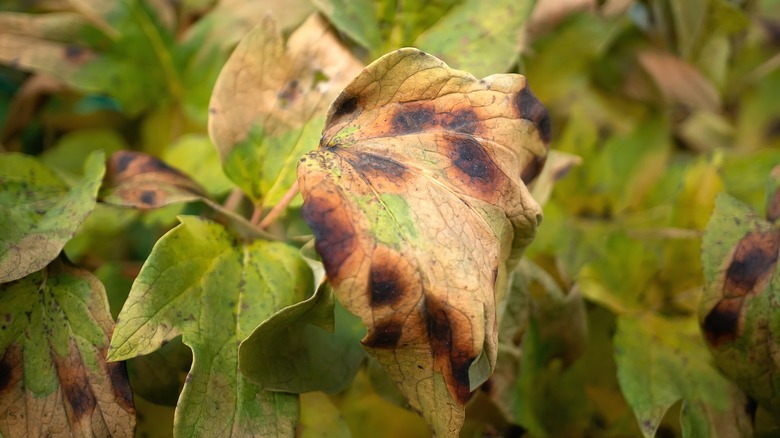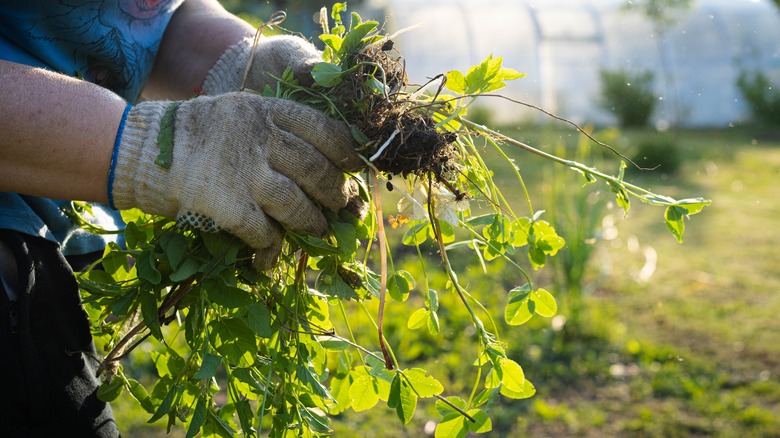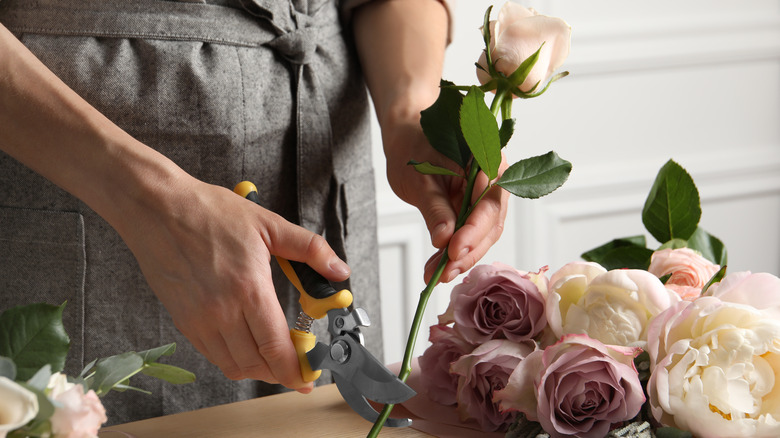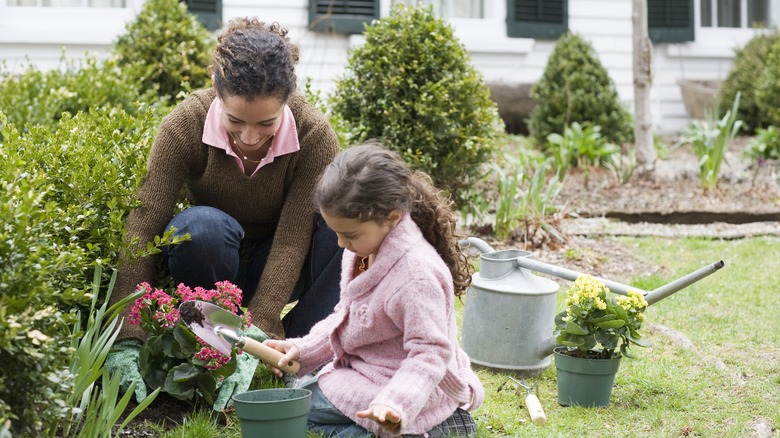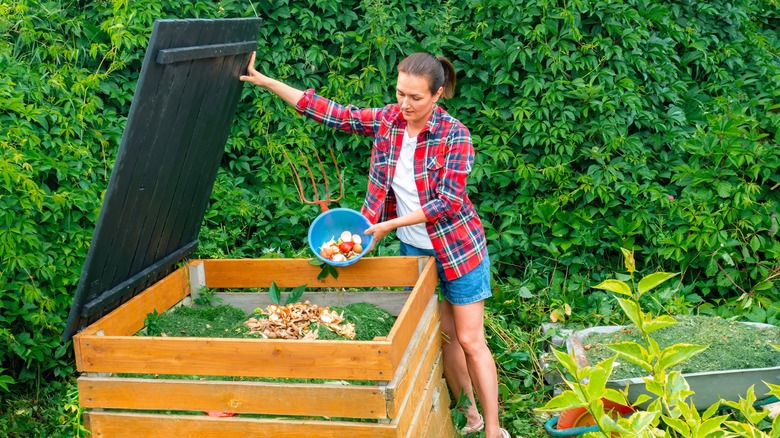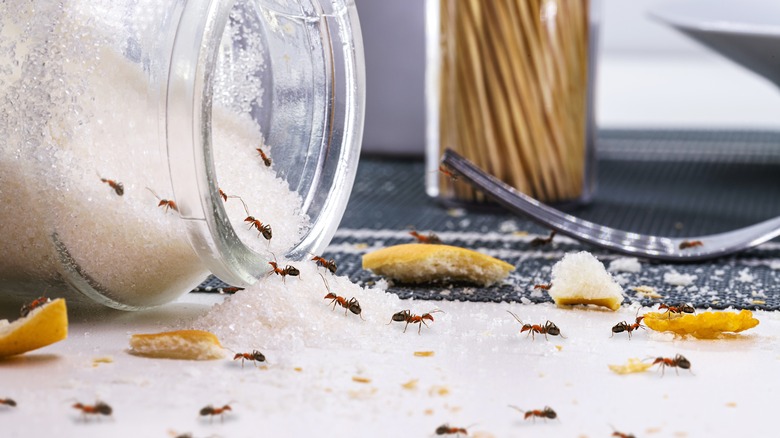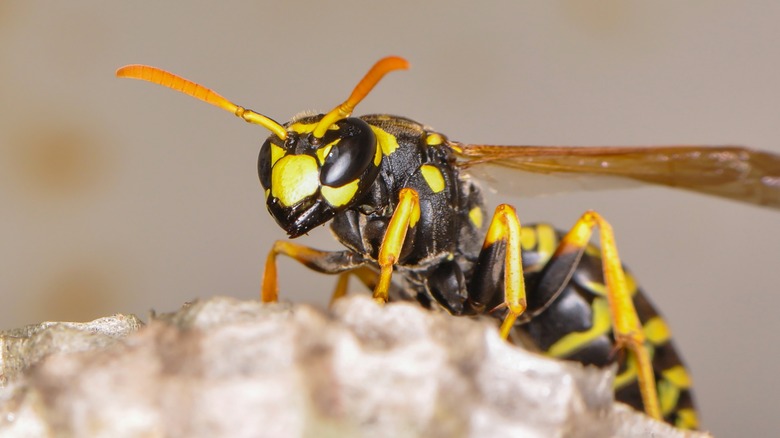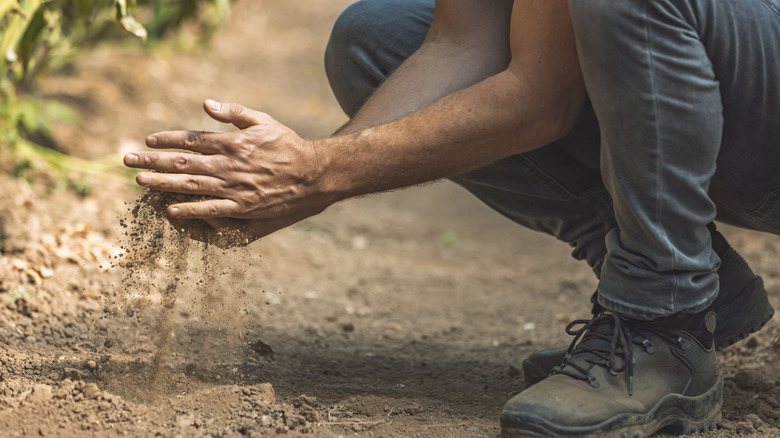All The Ways You Should Be Using Sugar In The Garden
Brown, white, confectioners, or coconut, the many versions of sweet sugar crystals play various roles in different industries. Its primary purpose is as an ingredient in food and beverages. But it's also used in cosmetics, pharmaceuticals, and even construction materials. The inexpensive product has yet another helpful use — as a versatile gardening aide.
If you garden, then the sweet stuff is a must on your grocery list as it can be the answer to many plant care woes. When bugs flock in, worms burrow into the soil, and weeds crop up, sugar can swoop in to save the day. It can make these and many other problems in the garden disappear. Plus, it's an inexpensive, readily available option and an awesome alternative to more chemical-based solutions. Here are the multiple reasons you should keep a basic bag of sugar on hand and how to use it to boost your garden.
Keep nematodes away
Root-knot nematodes are serious pests that attack the roots of garden plants. They live in the soil and latch on to the undergrown root system with their needle-shaped mouths. Nematodes can cause serious damage which stunts the growth of the plant. To confirm an infestation, uncover the roots and look for knots, lesions, and unusual branching. Nematodes happen to like the sweet taste of glucose, and that's how to keep these garden worms away. Sugar consumption decreases egg production in the worms which can in turn control their population. Plus, excessive intake can lead to stunted growth and premature death.
To apply the treatment, sprinkle the grains near the infected plants. Another option is to dissolve 1/2 cup of the sweetener in a gallon of water and pour it near the plants. However, too much of the syrup in the soil could make the plants worse as it can hinder the roots from absorbing water and nutrients. So, only apply the sugary water once every 10 to 14 days.
Attract common pollinators
Many garden visitors relish the taste of sucrose because it's easy to digest and quick to release its energy. Hummingbirds feed on nectars produced by flowers, but they'll switch to a sweet solution, instead. Bees enjoy the extra item on the menu in the early spring when flowers are scarce. Butterflies can also alternate between nectar and sweetened water depending on availability. These are all pollinators you would want to lure into your garden.
To feed hummingbirds and butterflies, dissolve 1 part of sugar into 4 parts of water and put it in a feeder. However, the syrup is prone to fermenting, so clean the feeder and replace the tasty water every other day. As for bees, they prefer a more concentrated syrup. Mix even amounts of sugar and hot water. Stir well to dissolve it, then pour the liquid into the bee feeder. Set these feeders out to draw these beneficial insects to your garden and watch as they pollinate your plants on the way to a snack.
Get rid of invasive nutsedge
Nutsedge is a member of the sedge family with two distinct varieties. Yellow nutsedge lives in cool to cold zones while purple nutsedge grows in more tropical areas. Once it takes root in the soil, little tubers develop on rhizomes underground, forming a vast network. The tubers remain inactive until the weed's existence is at stake. Then they come to life, sprouting new plants. Some people prefer to pull out nutsedge plants but that only increases the number of new shoots. A single nutsedge can cover an area of 10 feet. Instead of pulling the plants, sugar can wipe out the invasive nutsedge.
The sweetener does to nutsedge what it does to many weeds. It causes the microorganisms beneath the surface to become hyperactive. They consume the nitrogen in the soil and deplete other nutrients around the sedge. Then, the sedge will wither, and the extensive underground network of tubers shrivels and dies. Mix 1 cup of sugar in a gallon of water and apply it near the roots of the nutsedges. You'll likely need a few applications before you see results.
Revive dying plants
Caring for garden flora can be a handful for inexperienced gardeners. The plants wither and die if you don't water them enough or if you give them too much water. Not enough nutrients in the soil and little exposure to the sun might also hasten their demise. Sugar can be used as a remedy for reviving dying plants. However, it only works on flowers and vegetables suffering from nutrient deficiencies or poor sunlight. Sweetened syrup can be a substitute for the glucose the leaves make when processing sunlight. It can also boost the population of beneficial microorganisms in the soil that feed the plant.
Moderation is the operative word when treating fragile plants. Add 1 part of table sugar to 4 parts of lukewarm water and feed the greenery. Water the area around the base lightly, just enough to dampen it. Too much of the liquid saturating the soil could have adverse effects on the weak roots of the dying plants.
Eliminate stubborn lawn weeds
Weeds are the bane of gardens and lawns. They deprive plants of water and nutrients, cut off sunlight, and harbor pests. To combat the invasive plants, you could pull them out by hand. But that's a lot of work and it doesn't always eliminate them for good. Herbicides might help, but they pose health risks for you and could be lethal to other plants. Applied the right way, sugar can get rid of weeds in your lawn and garden. The granules deplete the nitrogen in the soil, leaving little nutrients for any undesirable plants.
The sweetener is effective against nitrogen-hungry varieties such as chicory and chickweed. Spread a cup of granulated sugar around the roots of the invasive weeds, making sure to avoid any plants you don't want to kill. Avoid watering the soil for as long as the weeds are alive, replenishing the sugar every few days. When they're dead, make sure to remove them along with the treated soil.
Make cut flowers last a little bit longer
Creating a cutting garden is time-consuming yet therapeutic as you grow the blooms from seeds. Surrounding yourself with cut flowers from your garden has diverse health benefits. It reduces stress, improves your mood, and can add a pop of color to your space. But cut flowers can have a brief shelf life. Depending on the type and conditions in and around the vase, the blossoms could last just a few days. Not if sugar has a say in the matter. The sweet stuff can make cut flowers look fresher for longer.
Not all flowers benefit from the sweet water in the vase. Daffodils and tulips belong to this group. But peonies, gladioluses, lilies, and sweet peas, among others, thrive in a sugary medium. Add a little sweetness to the vase and cut the stems at a 45-degree angle, to improve their nutrient intake. Every time you change the water in the vase, mix in a little sugar to extend their life.
Encourage healthy growth in plants
Plants make their own sugar through photosynthesis. That glucose is a crucial building block for garden vegetation to create tissue and cell walls. Without this energy, growth slows down, diseases spread, and flowering and fruiting might not even happen. In the absence of sunlight or dense foliage, sugar can be a suitable substitute. It works as a fertilizer, but not in the way you would expect.
Garden flora cannot process table sugar, but the energy-packed substance is food for the microbes in the soil. The tiny organisms break down organic matter, thus making the nutrients more accessible to the roots. To make a sweet syrup, fill a pot with 4 cups of water and bring it to a boil. Dissolve 1/4 cup of white sugar into the water and allow it to boil for 5 more minutes. After the syrup cools down, apply it to the plants, limiting the applications to once every two weeks. Don't use it to feed blooming plants since high intake can delay the flowering stage in some plants.
Give composting a vital boost
Hardcore gardeners know the value of homemade compost. The practice is more than just throwing food scraps onto the pile to decompose. Under the surface, bacteria are hard at work. They break down those organic layers and turn them into plant food. Needing energy to keep working, the glucose and fructose in the scraps often aren't enough to sustain their intensive labor. When they run out of food, work slows down, meaning you need a compost activator. And that's where sugar comes in.
The sweetener speeds up the composting process and increases the temperature inside the bin. That extra heat helps dry out an excessively wet patch of compost. Any leftover sugar will break down into compost. To apply, mix it into the compost with a pitchfork or garden rake to spread it around and aerate the pile. However, don't overuse this compost activator. Too much of the sweet stuff could attract pests and make a mess of a well-balanced pile of compost.
Send ants packing
Ants in the garden can cause indirect damage to your flower beds and veggie patches. When they dig up their nests, they disturb the soil around the roots, exposing them and causing wilting. They're also known to nibble at the leaves of garden foliage. So, it's time to fight back with sweet sugar.
When combined with other ingredients, the sweetener is lethal to ants. You'll need even amounts of sugar, dry yeast, and molasses. Mix well and serve on a plastic plate near their nest. After eating the yeast, their guts will swell and rupture.
Boric acid can also be effective in eliminating these pests. Mix equal portions of sugar and boric acid into a cup of water. Soak cotton balls in the solution and place them near the anthill. The sweetness in the liquid attracts the bugs, but the boric acid will kill them. As for baking soda, it has the same bloating effect inside their stomachs as yeast. Mix baking soda and powdered sugar equally on a paper plate and place it where ants can find it. The baking soda releases gasses inside their bodies, causing them to explode.
Improve rooting in seedlings and transplanted plants
Transplanting tomatoes, cucumbers, and other veggies into the garden can be troublesome. The seedlings could take a long time to grow and their root system remains underdeveloped. Transplant shock and insufficient nutrients in the soil would explain many of these symptoms. Some gardeners apply fertilizers rich in potassium and phosphorus to encourage fast root growth, but not without risks. Alternatively, sugar and yeast make an excellent homemade fermented fertilizer.
Yeast is packed with nutrients, but seedlings can't absorb them in their original condition. The sweetener feeds the microbes in the yeast to trigger fermentation and the breaking down of the nutrients. Mix 1 teaspoon of sugar and 1 tablespoon of yeast in 1 cup of water. To facilitate fermentation, set the liquid aside in a dark and warm place for a few days. After the fermentation is complete, mix the solution with an equal amount of water to dilute it. Apply the fertilizer to seedlings when transplanting them to trigger faster root development.
Set a trap for flying pests
To say that the garden is a magnet for pests is an understatement. But it's the flying ones that can be a real nuisance and harder to catch. Wasps are aggressive pests attacking bees and humans alike. They cause damage to tree bark and other plants. Although beneficial to the ecosystem, a colony of wasps is a menace in the garden. The same goes for flies that spread diseases and, sometimes, bite.
To capture the flying bugs, you'll need a one-liter empty soda bottle, sugar, and water. Cut off the top few inches of the bottle with a knife and remove the lid. Then, fill the bottom part with two cups of sugar dissolved into one cup of water. To finish the setup, flip the top part over to make a funnel and insert it into the bottom of the bottle. Now, set the bottle out in the garden where insects enter through the bottleneck and the top but stay trapped.
Scrub grime off your hands after a long day of gardening
Handling garden tools, digging, and pulling out weeds, give you dirty nails and greasy skin. Dishwashing liquid and detergents degrease and remove the baked grime — but at a cost. The harsh chemicals in the cleaning products can leave your hands sore and dry. Luckily, sugar works well on grime, grease, and a day's worth of dirt.
For plain grease, just the sweetener and water will do. Make a paste using 3 spoonfuls of sugar with a little water. Cover the greasy areas on your hands with the paste, massage gently, then rinse with running water. Repeat until the grease is gone. To remove ingrained grime, replace the water with a spoonful of vegetable oil to soften the gunk and soothe the skin. Adding a dash of lemon juice, slather the concoction all over your hands and under the nails. Rub your skin for a minute or two, then wash with soap and warm water to remove the oil.

